Those who say money can’t buy happiness have never seen a puppy! However, getting a new dog is not just all fun and games. You’re going to have to do a bit of work, and potty training your puppy is one of the most important tasks you’ll tackle.
We’ve put together this schedule for house training your puppy so that you’ll find it easier for your new friend to benefit from learning house rules and other good habits. It will also help your pet maintain optimum health because it lowers the risk of contracting diseases due to poor hygiene.
Let’s get to it!
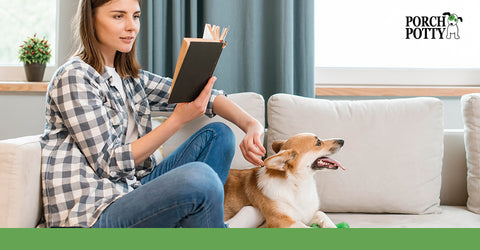
A woman in a flannel shirt and blue jeans sits on a white couch and reads a book while petting her puppy
Preparing for Potty Training
Housebreaking your dog is a task that you need to prepare for. Gather these tools before your new pup arrives:
A Dog Crate
- A sturdy, comfortable crate is one of the most important tools for potty training your puppy.
Poop Bags
- Sturdy poop bags are a must-have for any dog owner.
Potty Pads
- Using potty pads or a Porch Potty is one of the many ways pet owners make house training less stressful.
Treats
- Positive reinforcement is the way to go when you’re housetraining, whether you’re potty training an 8 week old puppy or an older dog. Whenever your dog gets something right, reward them with a treat and praise them.
You’ll also want to choose a specific area for your dog to do its business in. Aim for a spot that’s not visited by your other animals and that’s easy to clean up. Your puppy will get to associate the smells of this area with its pee and poop and go there automatically, making your job much easier.
Be sure and take your puppy to this area often, at least once every two hours when you’re potty training a 10-week-old puppy. You’ll also need to go to this spot after they’ve woken up, after playtime, and after they’ve eaten or drunk.
Potty Training Your Puppy Made Simple
Follow this weekly guide to get your puppy potty-perfect.
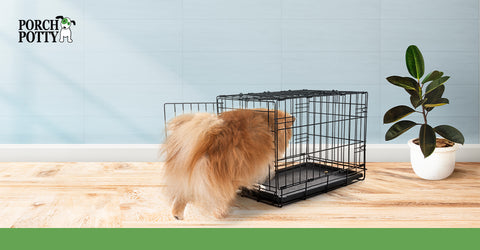
A Pomeranian puppy entering a small black wire crate in a room with hard wood floors and pale blue walls with a potted plant in the background
Week 1: Crate Training
You’ll need to properly introduce your new puppy to its crate. Try linking your command to a verbal cue, saying Crate whenever you want them to enter.
Encourage them by pointing to the inside of the crate with a treat in your hand.
When your doggy goes in, praise them, give them their treat, and shut the door. Sit quietly near the crate for 5-10 minutes and then head to another room for the same amount of time.
You’ll also want to create a feeding and bathroom schedule. This is important even if you’re potty training an adult dog as animals thrive with a consistent set of rules in place. While adult animals will only need to eat once or twice a day, puppies need at least one extra meal. Match your new pup’s feeding times to your own, giving them breakfast, lunch, and supper when you have yours. And make sure there’s always clean, fresh water available.
Do the same for their potty breaks. Take your puppy to their bathroom area every two to four hours after a change in activity.
Week 2: Establishing a Routine
A potty training schedule for puppies needs to be adjusted as your dog gets older and hits new milestones.
In the second week, you can start increasing the time between potty breaks, adding 15 minutes or so for every month of their age. So, if they’re two months old when you get them, they’ll be able to hold their bladders for roughly 3 hours and 15 minutes in the second week.
When you’re house training your puppy, encourage them to signal when they’re ready to poop or pee. When you see them starting to circle an area, lower their heads to the ground and sniffing, fidgeting, pacing, or whining, take that as your cue that they need to go, praise them, and take them to poop and pee.
You should also work on communicating when you want them to go. Known as Classical Conditioning, this kind of basic learning is known as reflexive and teaches your pup to associate a sound with doing their business. You can teach your little gal or fella to ring a bell when they need to go, bark at the door when they’re ready, or simply stand at the door until you open it.
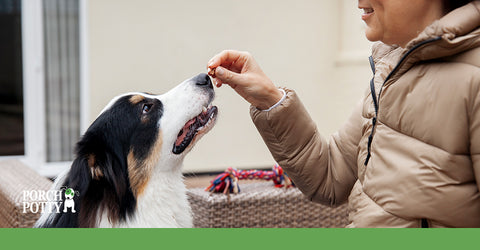
A puppy owner in a brown puffer jacket holds a treat up to their puppy's nose as it sits patiently
Weeks 3 & 4: Building Consistency
Your house training schedule for puppies needs to be as consistent as the one you stick to when feeding your new dog. This is really the only way to get your pup housebroken in the shortest amount of time possible.
When you’ve gotten to the third and fourth weeks of your potty training schedule for dogs, you should be able to start encouraging your pup to poop and pee outside. If you’ve been using a pad, Grass to Go, or a similar product, start by moving it closer to the area outside you want them to use.
When your puppy goes where you want it to, use your positive reinforcement technique and don’t forget to add the verbal cue as often as possible. We also recommend that you start taking them on longer walks at this point, or let them enjoy playing only after they’ve done their business.
Reinforce the good behavior you’re seeing by showering your new doggy with praise, their favorite treats, and the toys and games they love most. Most dogs are very food-motivated so treats work well but there are some who respond better to other rewards.
Weeks 5 & 6: Refining the Training
The fifth and sixth weeks are when you’ll want to start introducing new cues as you’re housebreaking your dog. This could be Do you want to go out?, for example, and you’d say it just before taking them to their potty area. Use the same upbeat tone and words each time, and choose something else to say for walks or visits to the park to help them differentiate between activities.
This is the point of potty training your 8-week-old puppy or older dog, to do what you want them to without treats. Implement a lottery reward system, handing out treats sporadically. Don’t neglect the praise, though! Give them all the verbal reassurance they need each time by using a happy tone and loving body language.
The main point to keep in mind when you’re potty training a 10-week-old puppy is that you’re going to need a lot of patience. Accidents are going to happen, although these will occur rarely if you’re consistent with your routines. Punishment will just hinder your progress, causing your dog to hide their poop or pee because they don’t understand what they did wrong. Your problem with accidents indoors will increase instead of decrease, and you’ll end up with a dog that’s afraid of you.
You need to react as calmly as you can. Even when you’re potty training an adult dog, if you catch them in the act, quietly interrupt and take them to the proper area to finish off. Don’t correct them or shout No! or Bad dog!, as this will simply make them avoid peeing or pooping in your presence.
Clean the spot immediately with an enzymatic cleaner and revise your supervision technique if necessary. If you find your dog using the same spot repeatedly, prevent their access to that part of the house for the foreseeable future, even after you’ve cleaned it up.
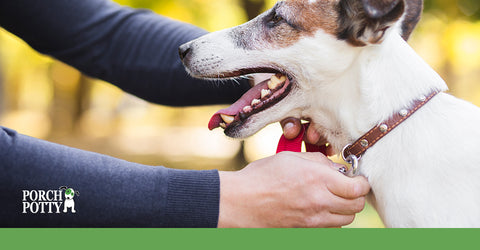
A puppy owner in a navy blue long-sleeve shirt is taking the leash off their puppy's red collar
Weeks 7-8: Graduating to Off-Leash
You’ve reached weeks seven and eight of your potty training schedule for puppies and you’re almost finished! Congratulations on making it this far.
It’s at this point you can start increasing freedom, and we recommend you keep your puppy off-leash as far as is safely possible from around 12 weeks. They’ll stick to you like glue at this age, so teach them good habits now. Walk back and forth, change direction, and make their rewards when they come back to you enormous. As long as you’re in a securely fenced area, you shouldn’t have anything to worry about with an off-leash dog at this stage of training.
You can also adjust your house training schedule for puppies to expand the dog’s range at this point. Once your pup has been accident-free for a week, add half an hour to their timer between poop and pee excursions. If you were taking them out hourly, take them out every 90 minutes now, and so on. Keep doing this until they’re able to hold their bladders for longer periods.
The best potty training schedule for dogs is one that’s constantly being refined. If accidents occur, figure out why and adjust what you’re doing accordingly.
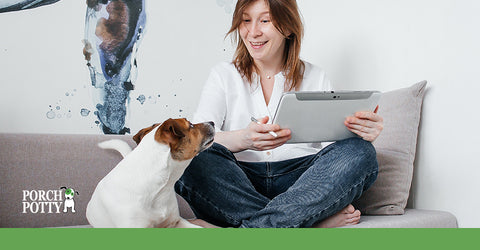
A puppy is looking at their smiling owner, dressed in a white shirt and blue jeans and holding a tablet
Recap and Final Tips and Advice for Success
Time to summarize what you need to do to ensure the potting training schedule for puppies you put into place works:
- Get the right tools.
- Be consistent.
- Be patient.
- Get a regular routine going for feeding and potty training.
- Remember to have fun!
Stick to having them potty in the same place and learn to spot the signs of your puppy needing to go. You’ll soon have a puppy that’s well-trained and ready to go on more adventures with you.
For more information on potty training your puppy, check out these articles:
Establishing a Successful Puppy Potty Training Routine



